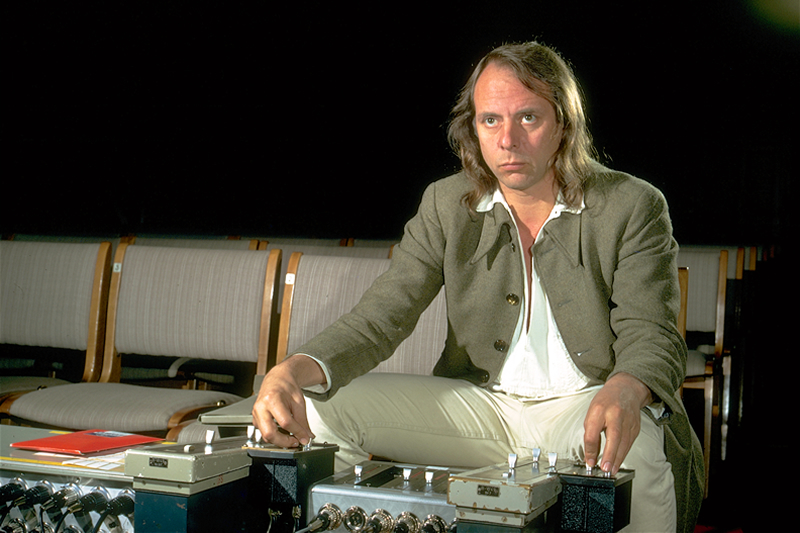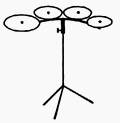
Instrumentation Works for Orchestra
Stockhausen Complete Edition on CD
Since 1991, a complete edition of all recordings in which Karlheinz Stockhausen has personally participated is being released on compact discs. Each CD in this series is identified by Stockhausen's signature followed by an encircled number. The numbers indicate the general historical order of the works.
Stockhausen realised the electronic music and participated in these recordings as conductor, performer, sound projectionist, and musical director. He personally mixed down the recordings, mastered them for CDs, wrote the texts and drew the covers.
- The compact discs may be obtained from the Stockhausen-Verlag: Kettenberg 15, 51515 Kuerten, Germany (www.stockhausenCDs.com).
Karlheinz Stockhausen
Instrumentation Works for Orchestra
FESTIVAL
ORCHESTRA
| 3 flutes (if possible, each also plays alto flute: see pp. F 26, F47, etc.) |
| 2 oboes |
| 1 English horn |
| 3 clarinets |
| 2 bassoons |
| 2 contrabassoons |
| 2 horns |
| 3 trumpets Each requires 5 mutes: see Notation |
| 4 trombones (2 with F-valve) 1st and 2nd require 4 mutes, the others require 3 mutes: see Notation. |
| 2 tubas |
| 1 synthesizer (having timbres which can be continuously changed) |
| 1 electric organ (having timbres which can be continuously changed, and various speeds for vibrato, for example Hammond organ) |
| 3 individual violins |
| 8-12 group violins |
| 6-8 group violas |
| 2 individual violoncelli |
| 4-6 group violoncelli |
| 2 individual double-basses |
| 4-6 group double-basses |
| 4 percussionists |
| Perc. 1 | ||
| Vib. 1 vibraphone | ||
Rin 4 rin  (see Explanations) |
||
Glsp. 1 glockenspiel |
||
4 glockenspiel bars  |
||
| Perc. 2 | ||
Cin. 4 cinelli  |
||
Cymb. ant. 2 antique cymbals  |
||
Rgl. 1 set of tubular bells  |
||
1 single tubular bell  |
||
| Perc. 3 | ||
Gongs 3 Thai gongs  (nipple gongs) |
||
Kpl. 3 sound plates  |
||
Pgl. 3 plate bells  |
||
| Perc. 4 | ||
| (Timpanist) | Pk. 2 pedal timpani  |
|
Tam. 3 tamtams  |
Explanatory Notes about the Instruments
Percussionists 1 and 2 have the pitch twice for each type of instrument. This enables them to make both instruments with the same pitch (or nearly the same) sound simultaneously during the bracketed sections indicating free shaping of this note
twice for each type of instrument. This enables them to make both instruments with the same pitch (or nearly the same) sound simultaneously during the bracketed sections indicating free shaping of this note , thus gaining many timbre variations from the resulting beats of pitch and dynamics.
, thus gaining many timbre variations from the resulting beats of pitch and dynamics.
1) Rin are brass-coloured metal cups used in Buddhist temple ceremonies in Japan. Their spectrum has a very long resonance and is exceedingly rich and pleasing to the ear. They are struck with wooden beaters which are covered halfway with skin. In Japan, these instruments with their cushions and beaters are found in specialised shops. Their diameter varies between ca. 6.5 cm and 15 cm. In order to assemble a fairly exact chromatic scale of pitches, it is necessary to try many rin. It is not possible to specify certain pitches when ordering rin.
The two should very slightly deviate from one another.
should very slightly deviate from one another.
Together with the conductor, the player decides on the use of the 2 rin beaters which are either played with felt, or turned around and played with the wooden handle. It is also possible to use wooden beaters without felt for "hart" and beaters with felt for "weich".
The beaters are struck against the edge of the rin.
2) A glockenspiel having the range would be even better. Since normal glockenspiels do not have the required pitches, 4 glockenspiel bars having the pitches
would be even better. Since normal glockenspiels do not have the required pitches, 4 glockenspiel bars having the pitches must be specially manufactured and mounted next to each other on a resonance box.
must be specially manufactured and mounted next to each other on a resonance box.
The glockenspiel part of the performance material is notated as sounding (thus, not 1 or 2 octaves lower as is customary).
3) The 4 cinelli required are small cymbals (ca. 27 cm in diameter).
These are mounted on a horizontal arc of iron on 4 metal pins having rubber holders. The arc is supported by a special stand.
side view: |
 |
The stand should be adjustable in height, so that the player can strike the cinelli from above, while standing. |
Cinelli have a brilliant, bright sound with a long resonance. Beaters used for cinelli have heads of hard caoutchouc and/ or hard wood for "hart" and of soft rubber or felt for "weich".
Instead of the cinelli, it is also possible to have 4 bronze crotales specially cast with the pitches
 . These are either hung next to each other or mounted on a resonance box.
. These are either hung next to each other or mounted on a resonance box.
4) Sound plates having specified pitches are made of Duralumin.
5) Plate bells are either thin bronze plates or very heavy plates made of bell material.
6) Tamtams with the prescribed pitches are not the thin, noisy, "hissing" tamtams, but heavy cast bronze Chau Luo tamtams which have a clear attack pitch when not struck too hard. If one cannot find these tamtams with the pitches then small tamtams one octave higher
then small tamtams one octave higher must be selected.
must be selected.
These pitches must in any case be correct.